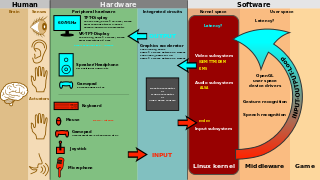Computer-supported cooperative work (CSCW) is the study of how people utilize technology collaboratively, often towards a shared goal. CSCW addresses how computer systems can support collaborative activity and coordination. More specifically, the field of CSCW seeks to analyze and draw connections between currently understood human psychological and social behaviors and available collaborative tools, or groupware. Often the goal of CSCW is to help promote and utilize technology in a collaborative way, and help create new tools to succeed in that goal. These parallels allow CSCW research to inform future design patterns or assist in the development of entirely new tools.
Interaction design, often abbreviated as IxD, is "the practice of designing interactive digital products, environments, systems, and services." While interaction design has an interest in form, its main area of focus rests on behavior. Rather than analyzing how things are, interaction design synthesizes and imagines things as they could be. This element of interaction design is what characterizes IxD as a design field, as opposed to a science or engineering field.

An information appliance (IA) is an appliance that is designed to easily perform a specific electronic function such as playing music, photography, or editing text.

Mixed reality (MR) is a term used to describe the merging of a real-world environment and a computer-generated one. Physical and virtual objects may co-exist in mixed reality environments and interact in real time.
User experience (UX) is how a user interacts with and experiences a product, system or service. It includes a person's perceptions of utility, ease of use, and efficiency. Improving user experience is important to most companies, designers, and creators when creating and refining products because negative user experience can diminish the use of the product and, therefore, any desired positive impacts. Conversely, designing toward profitability as a main objective often conflicts with ethical user experience objectives and even causes harm. User experience is subjective. However, the attributes that make up the user experience are objective.
Human-centered computing (HCC) studies the design, development, and deployment of mixed-initiative human-computer systems. It is emerged from the convergence of multiple disciplines that are concerned both with understanding human beings and with the design of computational artifacts. Human-centered computing is closely related to human-computer interaction and information science. Human-centered computing is usually concerned with systems and practices of technology use while human-computer interaction is more focused on ergonomics and the usability of computing artifacts and information science is focused on practices surrounding the collection, manipulation, and use of information.
Service design is the activity of planning and arranging people, infrastructure, communication and material components of a service in order to improve its quality, and the interaction between the service provider and its users. Service design may function as a way to inform changes to an existing service or create a new service entirely.

User interface (UI) design or user interface engineering is the design of user interfaces for machines and software, such as computers, home appliances, mobile devices, and other electronic devices, with the focus on maximizing usability and the user experience. In computer or software design, user interface (UI) design primarily focuses on information architecture. It is the process of building interfaces that clearly communicate to the user what's important. UI design refers to graphical user interfaces and other forms of interface design. The goal of user interface design is to make the user's interaction as simple and efficient as possible, in terms of accomplishing user goals.
Interaction design patterns are design patterns applied in the context human-computer interaction, describing common designs for graphical user interfaces.
Affective design describes the design of products, services, and user interfaces that aim to evoke intended emotional responses from consumers, ultimately improving customer satisfaction. It is often regarded within the domain of technology interaction and computing, in which emotional information is communicated to the computer from the user in a natural and comfortable way. The computer processes the emotional information and adapts or responds to try to improve the interaction in some way. The notion of affective design emerged from the field of human–computer interaction (HCI), specifically from the developing area of affective computing. Affective design serves an important role in user experience (UX) as it contributes to the improvement of the user's personal condition in relation to the computing system. Decision-making, brand loyalty, and consumer connections have all been associated with the integration of affective design. The goals of affective design focus on providing users with an optimal, proactive experience. Amongst overlap with several fields, applications of affective design include ambient intelligence, human–robot interaction, and video games.
User experience design, upon which is the centralized requirements for "User Experience Design Research", defines the experience a user would go through when interacting with a company, its services, and its products. User experience design is a user centered design approach because it considers the user's experience when using a product or platform. Research, data analysis, and test results drive design decisions in UX design rather than aesthetic preferences and opinions, for which is known as UX Design Research. Unlike user interface design, which focuses solely on the design of a computer interface, UX design encompasses all aspects of a user's perceived experience with a product or website, such as its usability, usefulness, desirability, brand perception, and overall performance. UX design is also an element of the customer experience (CX), and encompasses all design aspects and design stages that are around a customer's experience.

Immersive design describes design work which ranges in levels of interaction and leads users to be fully absorbed in an experience. This form of design involves the use of virtual reality (VR), augmented reality (AR), and mixed reality (MR) that creates the illusion that the user is physically interacting with a realistic digital atmosphere.
A narrative designer, or interactive narrative designer, is a role in contemporary video game development, the focus of which is to design the narrative elements of a game based on how players interact with its story, which differentiates it from video game writing.

Mobile interaction is the study of interaction between mobile users and computers. Mobile interaction is an aspect of human–computer interaction that emerged when computers became small enough to enable mobile usage, around the 1990s.

Human–computer interaction (HCI) is research in the design and the use of computer technology, which focuses on the interfaces between people (users) and computers. HCI researchers observe the ways humans interact with computers and design technologies that allow humans to interact with computers in novel ways. A device that allows interaction between human being and a computer is known as a "Human-computer Interface (HCI)".
Sonic interaction design is the study and exploitation of sound as one of the principal channels conveying information, meaning, and aesthetic/emotional qualities in interactive contexts. Sonic interaction design is at the intersection of interaction design and sound and music computing. If interaction design is about designing objects people interact with, and such interactions are facilitated by computational means, in sonic interaction design, sound is mediating interaction either as a display of processes or as an input medium.
User experience evaluation (UXE) or user experience assessment (UXA) refers to a collection of methods, skills and tools utilized to uncover how a person perceives a system before, during and after interacting with it. It is non-trivial to assess user experience since user experience is subjective, context-dependent and dynamic over time. For a UXA study to be successful, the researcher has to select the right dimensions, constructs, and methods and target the research for the specific area of interest such as game, transportation, mobile, etc.
Jared Spool is an American writer, researcher, speaker, educator, and an expert on the subjects of usability, software, design, and research. He is the founding principal of User Interface Engineering (UIE), a research, training, and consulting firm that specializes in website and product usability. He is also an amateur magician. Spool attended Niskayuna High School in Niskayuna, NY.
User research focuses on understanding user behaviors, needs and motivations through interviews, surveys, usability evaluations and other forms of feedback methodologies. It is used to understand how people interact with products and evaluate whether design solutions meet their needs. This field of research aims at improving the user experience (UX) of products, services, or processes by incorporating experimental and observational research methods to guide the design, development, and refinement of a product. User research is used to improve a multitude of products like websites, mobile phones, medical devices, banking, government services and many more. It is an iterative process that can be used at anytime during product development and is a core part of user-centered design.
Karen McGrane is a content strategist and website accessibility advocate, who wrote a book called Content Strategy for Mobile.





